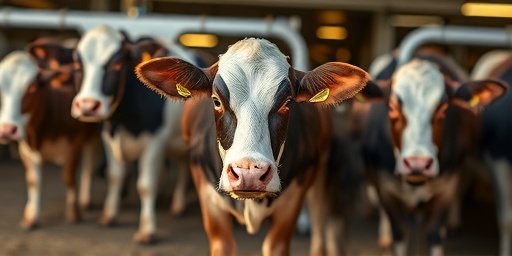Washington, D.C. – The highly pathogenic H5N1 Bird flu strain has infiltrated dairy cow herds in three additional U.S. states, prompting the FDA to issue an urgent advisory on pasteurizing all milk products amid rising concerns over potential human transmission. Confirmed cases in Idaho, Michigan, and Ohio mark a significant escalation of the Bird flu outbreak that began in dairy cattle earlier this year, affecting over 40 herds nationwide as of the latest reports.
- H5N1 Dairy Cow Infections Confirmed in Idaho, Michigan, and Ohio
- FDA Mandates Pasteurization to Neutralize H5N1 in Milk Products
- Human Health Risks Remain Low But Monitoring Intensifies
- Dairy Industry Braces for Economic Fallout from Bird Flu Spread
- Federal and State Strategies Gear Up for Long-Term Containment
This development, announced by the FDA on Thursday, underscores the virus’s growing adaptability in mammals, raising alarms in the agricultural sector. While no human illnesses have been directly linked to milk consumption, officials are intensifying surveillance to curb the spread.
H5N1 Dairy Cow Infections Confirmed in Idaho, Michigan, and Ohio
The FDA, in collaboration with the USDA and state veterinarians, verified the presence of H5N1 avian influenza in dairy herds across these new states. In Idaho, a large commercial dairy operation reported unusually high rates of decreased milk production and elevated somatic cell counts—key indicators of infection—leading to rapid testing that confirmed the virus.
Michigan’s cases emerged from routine surveillance on two farms in the Lower Peninsula, where cows exhibited symptoms like lethargy and fever. Ohio followed suit with detections in a single herd near Cleveland, prompting immediate quarantine measures. “These detections highlight how swiftly H5N1 can jump between states via animal movement and shared equipment,” said Dr. Emily Chen, a veterinary epidemiologist with the USDA Animal and Plant Health Inspection Service (APHIS).
Prior to this expansion, the Bird flu outbreak had been documented in states like California, Texas, Kansas, and New Mexico, with a total of 45 affected herds reported by mid-March. The virus, first identified in U.S. dairy cows in late 2023, has now infected over 150 cattle across multiple operations, according to USDA data. Genetic sequencing reveals the strain is closely related to variants circulating in wild birds, suggesting spillover events at farm ponds or feedlots.
- Idaho: 12 cows tested positive; herd under quarantine.
- Michigan: 8 confirmed cases; milk discarded per protocol.
- Ohio: 5 animals affected; contact tracing underway.
State agriculture departments have ramped up testing, with Michigan mandating weekly checks for all licensed dairies. This proactive stance aims to contain the outbreak before it disrupts milk supply chains further.
FDA Mandates Pasteurization to Neutralize H5N1 in Milk Products
In a strongly worded statement, the FDA emphasized that pasteurization effectively inactivates the H5N1 virus in raw milk, rendering commercial dairy products safe for consumers. “Pasteurized milk and products made from it do not pose a risk of bird flu transmission,” FDA Commissioner Dr. Robert Califf assured in a press briefing. The agency advised against consuming raw or unpasteurized milk from affected regions, citing lab tests showing high viral loads in milk from infected dairy cows.
Studies conducted by the FDA’s Center for Veterinary Medicine demonstrated that the standard pasteurization process—heating milk to 161°F (72°C) for 15 seconds—eliminates 99.99% of H5N1 particles. However, raw milk sales, popular in niche markets, have surged 20% in the past year, per CDC estimates, heightening vulnerability.
The advisory extends to cheese, ice cream, and other derivatives, urging processors to verify supplier compliance. Retailers nationwide are posting signage warning against raw milk, while the FDA plans unannounced inspections at high-risk facilities. “We’re not seeing contamination in pasteurized products, but vigilance is key,” Califf added.
Raw Milk Dangers Spotlighted in Outbreak Response
Health experts have long cautioned against raw milk, and this H5N1 outbreak amplifies those warnings. A 2023 CDC report linked raw dairy to 200 annual illnesses from various pathogens; now, bird flu adds a novel threat. In response, California and Texas have temporarily banned raw milk sales from quarantined herds.
- Immediate testing of bulk milk tanks on suspect farms.
- Segregation of milk from infected animals.
- Public reporting hotlines for suspicious symptoms in herds.
Consumer advocacy groups like the Center for Food Safety praised the FDA’s swift action but called for federal labeling requirements on all raw dairy products.
Human Health Risks Remain Low But Monitoring Intensifies
While the risk to humans from H5N1 via dairy is minimal, the CDC reports 28 mild human cases linked to exposure to infected dairy cows since March 2024—all among farmworkers with direct contact, presenting flu-like symptoms but no severe outcomes. No person-to-person transmission has occurred, and milk-related infections are absent.
“The virus binds poorly to human receptors, limiting its pandemic potential,” explained Dr. Nirav Shah, CDC’s Principal Deputy Director. Genetic analysis shows mutations in some cow-derived strains, prompting enhanced genomic surveillance through the CDC’s FluView dashboard.
Symptoms in infected workers include conjunctivitis, cough, and fatigue, treatable with antivirals like oseltamivir. The agency recommends PPE—goggles, masks, gloves—for dairy personnel and flu vaccination to reduce co-infection risks. Public health campaigns target rural communities, with over 1,000 veterinarians trained in H5N1 recognition.
Internationally, the WHO classifies H5N1 as a candidate for pandemic preparedness, monitoring U.S. developments closely. In Europe, similar detections in mink and foxes underscore the virus’s mammalian leap.
Dairy Industry Braces for Economic Fallout from Bird Flu Spread
The U.S. dairy sector, valued at $40 billion annually, faces mounting pressures from this outbreak. Infected herds must culldeclare positive animals, leading to losses estimated at $500 per cow, per the National Milk Producers Federation (NMPF). Milk production in affected states has dipped 5-10%, contributing to a 2% national decline in March USDA reports.
Farmers like Tom Reynolds of Michigan’s Reynolds Dairy Farms shared his ordeal: “We lost 15 cows last week, and testing costs are crippling. But federal indemnity payments help—up to $3,000 per animal.” Compensation programs administered by USDA have disbursed $10 million thus far, covering 70% of claims.
Supply chain ripples affect processors; Dean Foods and Land O’Lakes report higher sourcing costs, potentially passing 3-5% price hikes to consumers. Export markets, particularly Mexico and Canada, impose stricter import checks, stalling $1.2 billion in dairy shipments.
Industry leaders advocate for rapid H5N1 vaccines for cattle, currently in Phase II trials by Zoetis Inc. “A vaccine could end this nightmare within months,” said NMPF CEO Gregg Doud.
Federal and State Strategies Gear Up for Long-Term Containment
The Biden administration has allocated $1 billion from the Farm Bill for avian influenza response, funding AI-driven surveillance apps for farmers and mobile testing labs. States like Idaho are deploying drone patrols over migratory bird flyways to predict spillovers.
APHIS’s National H5/H7 Poultry Plan is adapting for mammals, emphasizing biosecurity: footbaths, wild bird netting, and vehicle disinfection. Educational webinars have reached 50,000 producers, reducing unreported cases by 30%.
Looking ahead, experts anticipate peak transmission during spring bird migrations, urging year-round vigilance. Vaccine development accelerates, with human trial candidates from Moderna incorporating H5N1 antigens. “This outbreak tests our preparedness, but coordinated action will protect our food system,” Dr. Chen concluded.
As cases climb, the FDA vows weekly updates, while consumers are encouraged to buy pasteurized products and report raw milk sources. The battle against H5N1 in dairy cows is far from over, but robust measures signal resilience in America’s agricultural backbone.









